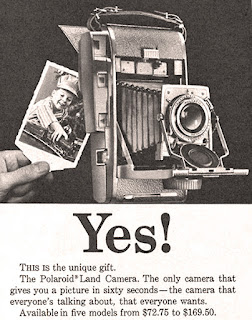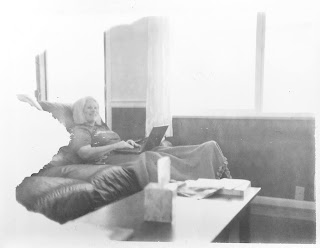Recently, I had some time after a very busy summer and fall to catch-up with gear. Maintenance is an endless task when you own gear. I stumbled across an old case on the back of a shelf. Inside was this:
It is my Polaroid Pathfinder, model 110B. It is a really cool camera I kinda forgot I even had. It was for test pictures on film shoots for evaluating exposure. I haven't used it in years.
 |
| An old ad for the Pathfinder I found online |
The Pathfinder was a high-end camera from Polaroid that used instant film. It was an expensive camera intended for professional photographers. Unlike most Polaroid cameras, the Pathfinders have an adjustable shutter and iris. Another great feature is a sophisticated optical range-finding focus; your image is in focus when the double images merge in the viewfinder. The quality of these cameras is top notch.
Pathfinders used Polaroid roll film which has not been manufactured in a long time. This camera has been modified to use pack film.
I'm guessing it has been almost 10 years since I last used this camera. That would have been my last film shoot.
The camera (to my surprise) still had film in it. Generally, it is not good to leave Polaroid film in the camera for a long period of time. I'm guessing I must have been planning to use the camera on another job that never happened.
I took a few pictures with the old film. Most didn't come out; the chemicals had dried out. Here is one that partially developed:
 |
| The film is so old, I'm surprised anything developed. |
I've been keeping the camera all these years in case I got another film job. I have interviewed for a few movies that were planning to shoot film.
I'm not even sure about availability of pack film. Back in the day, Polaroid had discontinued production. Fuji was making pack film, but they were discontinuing it, too. There were some startups making it, but I don't know if it is still available.
In the bottom of the camera case were a few old test pictures:
I often took test pictures like this with a gray scale to check that the exposure was centered on the scale.
This picture is my son doing high school homework. Again, most likely a test picture to make sure the exposure was correct.
(Time flies! He is now a lawyer and married with 2 kids!)
Getting a correctly developed print from a Polaroid camera takes a bit of skill. The development time varies according which type of film was in the camera, and the tricky part, the time varies according to the temperature.
This test picture is from a sporting commercial. The sun is giving a nice side/back key. I'm thinking there is an 18K on the fill side probably through a large frame.
I'm uncertain what the flare is from. I'm thinking there maybe a pinhole in the bellows that only is an issue working out in the sun.
The framing may seem odd in these test pictures. I am not trying to duplicate the framing. Rather, my interest is in the exposure.
I'm guessing this test picture is from the same commercial.
I always used black & white film. I'm only evaluating exposure. It is easier to do this in black and white.
Another
interesting thing with test picture; I often would see something I
would want to change that I hadn't noticed with my eye. I think it
helps that you are looking at a black & white image and are not
distracted by the colors.
I occasionally bought some color film for fun. I was never pleased with the look of it. The color quality of Polaroid film never seemed quite right.
Here is another test picture from a commercial. It shows a nice range of values from whites to blacks with skin tones looking well centered.
PS: There is something magical about Polaroid instant film. It was amazing that you could take a picture and a minute later, have a photograph. It really is amazing technology.
Everything you ever want to know about Polaroid instant film:
https://en.wikipedia.org/wiki/Instant_film





